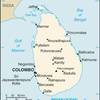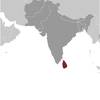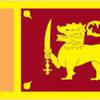Sri Lanka [+]Compare [E]dit [H]istory
Aliases: Democratic Socialist Republic of Sri Lanka, Serendib, Shri Lanka Prajatantrika Samajavadi Janarajaya/Ilankai Jananayaka Choshalichak Kutiyarachu, Shri Lanka/IlankaiObject «Sri Lanka» was created due to
Add new object to «Sri Lanka» or move existing objects here.
Object «Sri Lanka» has attributes [Show empty attributes][Hide empty attributes]
| Attribute | Value |
|---|---|
| Geography | |
| Area | 65,610 km² |
| Continent | Asia |
| Land area | 64,630 km² |
| Water area | 980 km² |
| Land boundaries | 0 km |
| Border countries | Add |
| Coastline | 1,340 km |
| Mean elevation | 228 m |
| Lowest point | 0 m |
| Highest point | 2,524 m |
| People | |
| Population | 22,889,201 |
| Official languages |
|
| Religion | Buddhist |
| Government | |
| Long country name | Democratic Socialist Republic of Sri Lanka |
| Short country name | Sri Lanka |
| Long local name | Shri Lanka Prajatantrika Samajavadi Janarajaya/Ilankai Jananayaka Choshalichak Kutiyarachu |
| Short local name | Shri Lanka/Ilankai |
| Former name |
|
| Government type | Presidential republic |
| Capital | Colombo |
| Economy | |
| GDP (PPP) | 275,800,000,000 USD |
| GDP (OER) | 87,350,000,000 USD |
| GDP (real growth rate) | 3.3 % |
| GDP - per capita (PPP) | 12,900 USD |
| Gross national saving | 33.8 % of GDP |
| Labor force | 8,937,000 |
| Unemployment rate | 4.4 % |
| Population below poverty line | 6.7 % |
| Budget revenues | 12,070,000,000 USD |
| Budget expenditures | 16,880,000,000 USD |
| Military expenditures | 1.89 % of GDP |
| Taxes and other revenues | 13.8 % of GDP |
| Budget surplus or deficit | -5.5 % of GDP |
| Public debt | 79.1 % of GDP |
| Inflation rate | 6.5 % |
| Central bank discount rate | 7.25 % |
| Commercial bank prime lending rate | 11.6 % |
| Stock of narrow money | 5,190,000,000 USD |
| Stock of broad money | 5,190,000,000 USD |
| Stock of domestic credit | 53,530,000,000 USD |
| Market value of publicly traded shares | 18,900,000,000 USD |
| Current account balance | -2,310,000,000 USD |
| Exports | 11,360,000,000 USD |
| Imports | 20,980,000,000 USD |
| Reserves of foreign exchange and gold | 7,959,000,000 USD |
| External debt | 51,720,000,000 USD |
| National currency | Sri Lankan rupees |
| National currency (code) | LKR |
| National currency (symbol) | ₨ |
| National currency rate to USD | 154.1 |
The first Sinhalese arrived in Sri Lanka late in the 6th century B.C., probably from northern India. Buddhism was introduced circa 250 B.C., and the first kingdoms developed at the cities of Anuradhapura (from circa 200 B.C. to circa A.D. 1000) and Polonnaruwa (from about 1070 to 1200). In the 14th century, a south Indian dynasty established a Tamil kingdom in northern Sri Lanka. The Portuguese controlled the coastal areas of the island in the 16th century followed by the Dutch in the 17th century. The island was ceded to the British in 1796, became a crown colony in 1802, and was formally united under British rule by 1815. As Ceylon, it became independent in 1948; its name was changed to Sri Lanka in 1972. Prevailing tensions between the Sinhalese majority and Tamil separatists erupted into war in July 1983. Fighting between the government and Liberation Tigers of Tamil Eelam (LTTE) continued for over a quarter century. Although Norway brokered peace negotiations that led to a ceasefire in 2002, the fighting slowly resumed and was again in full force by 2006. The government defeated the LTTE in May 2009. During the post-conflict years under President Mahinda RAJAPAKSA, the government initiated infrastructure development projects, many of which were financed by loans from China. His regime faced significant allegations of human rights violations and a shrinking democratic space for civil society. In 2015, a new coalition government headed by President Maithripala SIRISENA of the Sri Lanka Freedom Party and Prime Minister Ranil WICKREMESINGHE of the United National Party came to power with pledges to advance economic, governance, anti-corruption, reconciliation, justice, and accountability reforms. However, implementation of these reforms has been uneven. In October 2018, President SIRISENA attempted to oust Prime Minister WICKREMESINGHE, swearing in former President RAJAPAKSA as the new prime minister and issuing an order to dissolve the parliament and hold elections. This sparked a seven-week constitutional crisis that ended when the Supreme Court ruled SIRISENA’s actions unconstitutional, RAJAPAKSA resigned, and WICKREMESINGHE was reinstated.
Similar objects
Most often compared with
Everyone can something to edit or add.
There were 2 edits, no edits waiting approval. Last edited by Guest_1196(-101), May 26, 2020 (51 fields were changed)
Help · Contact us · Disclaimer · Contributors · Developers · Donate


